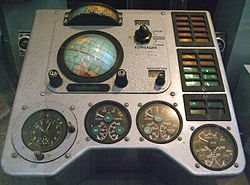Vostok 1
Vostok 1 (Russian: Восто́к, East or Orient 1) was the first flight to take a human into space. It used a Vostok 3KA spacecraft, and was launched on April 12, 1961.[7] It took into space Yuri Gagarin, a cosmonaut from the Soviet Union. The Vostok 1 mission was the first time a person went into outer space and the first time anyone had entered into orbit. The flight made one orbit and lasted for 1 hour, 48 minutes.[7]: Script error: The function "hyphen2dash" does not exist.  The Vostok 1 was launched by the Soviet space program and made by the Soviet rocket scientists Sergei Korolev and Kerim Kerimov.
 Model of the Vostok spacecraft | |
| Operator | Soviet space program |
|---|---|
| Harvard designation | 1961 Mu 1 |
| COSPAR ID | |
| SATCAT no. | 103 |
| Mission duration | 1 hour, 48 minutes[1] |
| Orbits completed | 1 |
| Spacecraft properties | |
| Spacecraft | Vostok-3KA No.3 |
| Manufacturer | Experimental Design Bureau OKB-1 |
| Launch mass | 4,725 kg (10,417 lb)[1] |
| Landing mass | 2,400 kg (5,290 lb) |
| Dimensions | 2.30 m (7 ft 6.5 in) diameter |
| Crew | |
| Crew size | 1 |
| Members | Yuri Gagarin |
| Callsign | Кедр (Kedr – Siberian pine)[2] |
| Start of mission | |
| Launch date | April 12, 1961, 06:07 UTC[3] |
| Rocket | Vostok-K 8K72K |
| Launch site | Baikonur 1/5 45°55′13″N 63°20′32″E / 45.920278°N 63.342222°E[4] |
| End of mission | |
| Landing date | April 12, 1961, 07:55 UTC |
| Landing site | 51°16′14″N 45°59′50″E / 51.270682°N 45.99727°E[5][6] |
| Orbital parameters | |
| Reference system | Geocentric |
| Regime | Low Earth |
| Perigee | 169 km (91 nmi)[3] |
| Apogee | 327 km (177 nmi)[1] |
| Inclination | 64.95 degrees[3] |
| Period | 89.1 minutes |
| Epoch | April 12, 1961 |
 Yuri Gagarin in Sweden Vostok programme Manned flights | |
The Vostok spacecraft weighed 4.73 t (10,400 lb), was 4.4 m (14 ft) long and 2.43 m (8.0 ft) in diameter.[7]: Script error: The function "hyphen2dash" does not exist.  The cosmonaut flew inside a spherical module. He sat on a seat which was also an ejection seat which allowed the cosmonaut to escape from the spacecraft in case of an emergency. The flight was simple, the cosmonaut was simply a passenger.[7]: Script error: The function "hyphen2dash" does not exist.  There were controls for use in an emergency.[8] The spacecraft had a food locker, radio, a cabinet with experiments inside, and two windows, one above the ejection seat and one to the right.. Gagarin ejected from the spacecraft after re-entry and landed by parachute.
There were six manned Vostok flights, the last one, Vostok 6, carried Valentina Tereshkova, the first woman to go into space on June 16, 1963.[7]: Script error: The function "hyphen2dash" does not exist. 
Vostok 1 Media
Part of the Vostok 1 instrument panel prominently displaying the "Globus" navigation instrument
Electrocardiogram of Gagarin recorded 11 April 1961, at 19 hours and 35 minutes. Exhibited at the Memorial Museum of Cosmonautics in Moscow.
Gagarin with Korolev (right) before the flight
The Vostok 1 capsule when it was on display at the RKK Energiya museum. The main capsule, seen in the center of this picture, is now on display at the Space Pavilion at the VDNKh.
Commemorative monument, Vostok-1 landing site near Engels, Russia
References
- ↑ 1.0 1.1 1.2 "Aviation and Space World Records". Fédération Aéronautique Internationale (FAI). Archived from the original on July 26, 2009. Retrieved March 12, 2009.
- ↑ Siddiqi, p.275
- ↑ 3.0 3.1 3.2 "Vostok 1 – NSSDC ID: 1961-012A". NASA. Archived from the original on December 13, 2012. Retrieved June 19, 2019.
- ↑ "Google Maps – Vostok 1 Launch Pad – Gagarin's Start photo". Retrieved December 25, 2010.
- ↑ "Google Maps – Vostok 1 Landing Site – Monument". Retrieved December 25, 2010.
- ↑ "Google Maps – Vostok 1 Landing Site – Monument Photo". Retrieved December 25, 2010.
- ↑ 7.0 7.1 7.2 7.3 7.4 Furniss, Tim (2001). The History of Space Vehicles. London: Grange Books. ISBN 1-84013-370-8.
- ↑ "Vostok 1". astronautix.com. 2011. Retrieved August 11, 2012.






